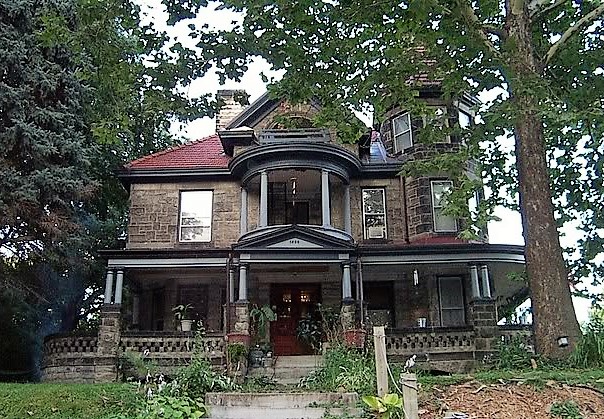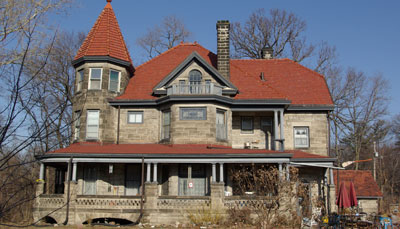Amazing House Story

According to the Kelly family, John Looney liked his law partner’s house across the avenue so well that he also contracted with architect Stauduhar to have a similar Queen Anne home built. However, Looney requested some obvious alterations that juxtapose fantastically with Kelly’s frilly confection. The gray stone veneer (very rare in Rock Island residences), French clay tile roof, and three-story corner tower give the mansion its massive, almost brooding appearance. Another major difference is the use and design of the porches. The first floor porch wraps around the entire south and west walls with classical Tuscan columns. There are two second-story porches: one rectangular and one semi-circular. Then, there are three well-defined balustrades at the third story that also have the appearance of porches. Add in the rugged chimneys and the arched openings under the porch, and this certainly becomes a different type of Queen Anne house.
Although John Patrick Looney controlled vice and gambling in Rock Island for nearly 20 years, his tenure in this house from 1895 until 1909 was concurrent with early criminal activity and the establishment of his family. Looney’s wife was Nora O’Connor, who was known to be a normal woman of her time, quite religious and not involved with Looney’s early shenanigans. They had met and married in Ottawa, Illinois, where daughters Kathleen and Ursula were born. Son Connor Looney was born on November 19, 1900, while the Looney family lived here. Tragically, Nora died in 1903 from cancer, and after Nora’s death, Looney’s petty crimes turned much more serious. Eventually, Ursula married a rancher from New Mexico, daughter Kathleen became a nun, and Connor followed his father’s footsteps to infamy.
The base of Looney’s power was in control of liquor, gambling, and prostitution in the city. He secured power through violence and with his newspaper The Rock Island News, the epitome of yellow journalism. Looney routinely used lies and slander in his newspaper to blackmail community leaders. He used brutality and intimidation to enforce his will and he was very successful. In 1922, a shocking six murders in Rock Island were tied to Looney. The most outrageous crimes began around 1912 when the notorious Looney printed a scandalous article whose headline screamed “Schriver’s Shame! Spent Night and Day in Peoria in Filthy Debauch with Ethel: Deeds that Would Shame a Dog!” The slanderous story that followed had Rock Island’s Mayor Schriver in and around hotels, saloons, brothels and prostitutes. With the publication of this story on March 13,1912, Schriver had all 18 newsboys arrested and their papers confiscated. The police found Looney and delivered him to the mayor’s office, where Schriver beat Looney so severely he required an extended stay at St. Anthony’s Hospital.
The following day, Looney followers organized a supposed political rally for Harry McCaskrin, a lawyer and The Rock Island News writer was running for State’s Attorney. As it turned out, McCaskrin’s fiery speech became a personal attack on Mayor Schriver, and two nights of rioting broke out in downtown Rock Island. Two innocent bystanders were slain, eight people were shot, and dozens of others were wounded. The sheriff, panicked by the extent of the riot, phoned Illinois Governor Charles Deneen, who immediately declared martial law and called out 600 National Guardsmen. The militia remained in Rock Island for nearly 30 days, until after the election.
In the aftermath of the riot, Looney temporarily retreated to daughter Ursula’s New Mexico ranch. However, he returned to Rock Island in 1917 and quickly regained control of all his former illegal operations. While Looney had been away, others formed their own gangs. Rival groups, headed by many of Looney’s former associates, had tasted power and money. Sharing any of it with Looney caused resentment, jealousy, and eventual defiance. Former lieutenants Anthony Billburg, George Holsapple, Dan Drost, and Bill Buckley were frustrated with Looney’s management of local vice and wanted a bigger piece of the action. On October 6, 1922, they waited outside the Sherman Hotel in downtown Rock Island to ambush him. When Looney got out of his car and saw Billburg’s black Maxwell parked across the street, he shouted to the others with him to run and duck behind his car. Young Connor Looney, who had developed his own nasty reputation as a high-strung, unpredictable gangster with excellent aim, drew a gun and turned to face Billburg’s men. In the ensuing gunfire, 21-year-old “Crazy Connor” was killed.
The Looney Mansion is one of the most interesting historical and architectural residences in Rock Island. It was the inspiration for the dark, almost gothic, setting for some of the early scenes in the book and film “The Road to Perdition.” A drawing of this house is in Max Allan Collins’ original graphic novel, in which the film is based. The John Rooney character in the 2001 movie, played so expertly by Oscar-nominee Paul Newman, was based on John Looney.
What eventually brought Looney down were a paper trail, a murder, and the relentless, fiery editorials of The Rock Island Argus. Saloonkeeper Bill Gabel had long been paying Looney protection money but balked at increased fees. Gabel and Looney ultimately worked out a payment deal. Gabel paid with checks instead of the customary cash. When Gabel decided to hand evidence of these checks over to federal investigators, word of his betrayal got back to Looney. Gabel met agents at the Como Hotel on the night of July 31, 1922. Later that evening he was ambushed in front of his tavern. A bullet to the head killed him instantly.
Several months later, Looney fled Rock Island to avoid prosecution for Gabel’s murder. One year later, he was apprehended in New Mexico where he was tried, convicted, and sentenced to 14years at the State Penitentiary at Joliet. There was no direct evidence that tied Looney to Gabel’s murder, only the testimony of Looney’s gang members, who traded Looney for leniency.
John Looney was nearly 70 years old when he was released after nine years in prison. He retreated again to the Southwest, and died in 1947 of tuberculosis in a sanitarium in El Paso, Texas.
By 1910, Looney sold his home to Herbert Casteel, president of the Rock Island National Bank and Central Trust & Savings Bank, who owned it just six years. After going through several owners, the house was converted to Hillcrest Apartments in 1939. It remained apartments for more than 50 years, but is now back to private ownership.





